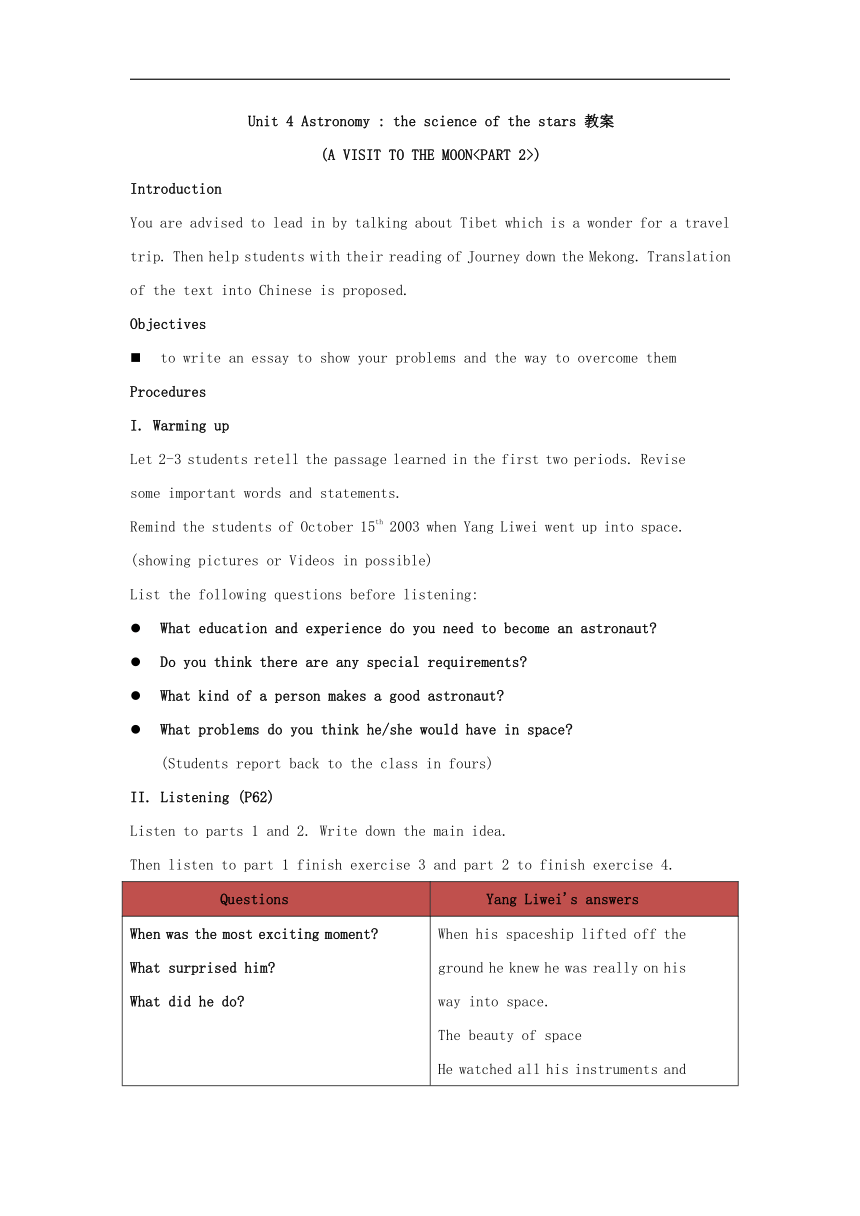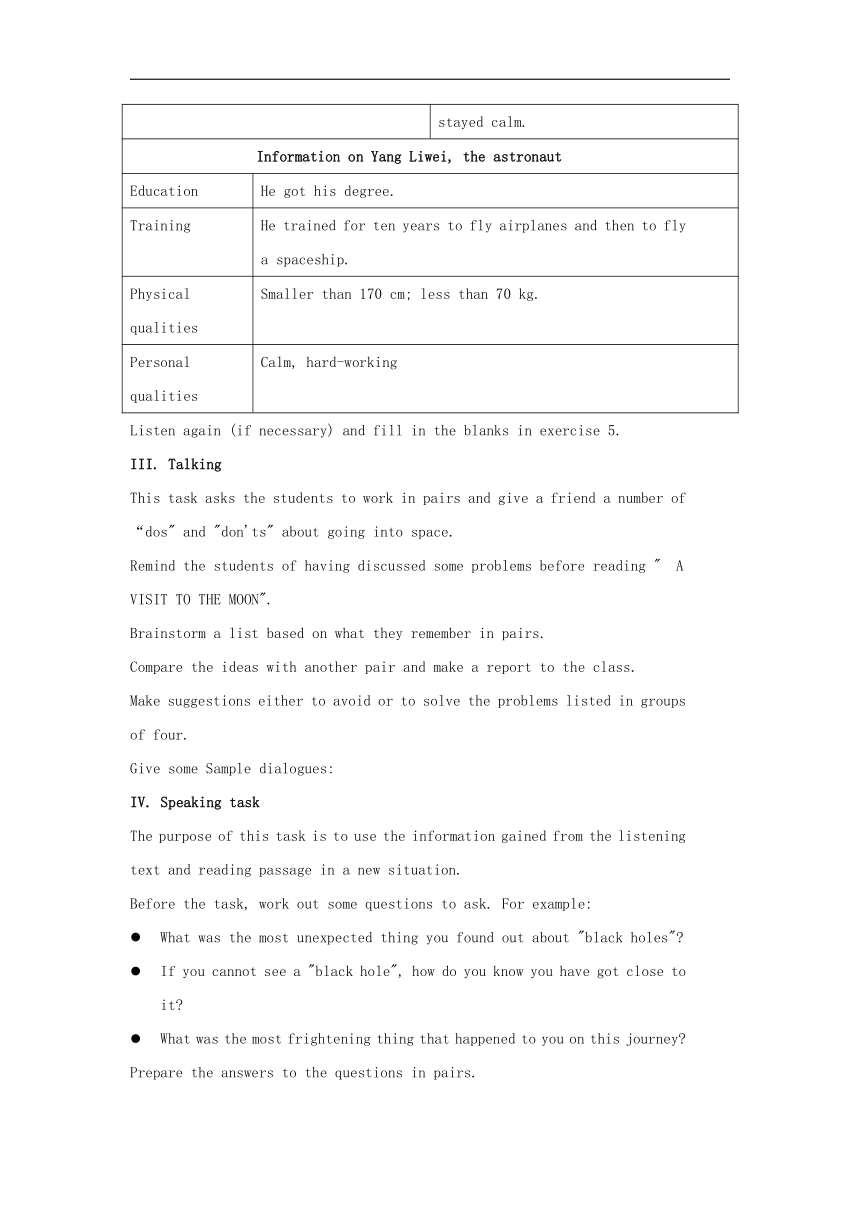新人教版必修3:Unit 4 Astronomy the science of the stars教案
文档属性
| 名称 | 新人教版必修3:Unit 4 Astronomy the science of the stars教案 |  | |
| 格式 | zip | ||
| 文件大小 | 8.4KB | ||
| 资源类型 | 教案 | ||
| 版本资源 | 人教版(新课程标准) | ||
| 科目 | 英语 | ||
| 更新时间 | 2019-04-22 23:00:59 | ||
图片预览


文档简介
Unit 4 Astronomy : the science of the stars 教案
(A VISIT TO THE MOON)
Introduction
You are advised to lead in by talking about Tibet which is a wonder for a travel trip. Then help students with their reading of Journey down the Mekong. Translation of the text into Chinese is proposed.
Objectives
to write an essay to show your problems and the way to overcome them
Procedures
I. Warming up
Let 2-3 students retell the passage learned in the first two periods. Revise some important words and statements.
Remind the students of October 15th 2003 when Yang Liwei went up into space. (showing pictures or Videos in possible)
List the following questions before listening:
What education and experience do you need to become an astronaut?
Do you think there are any special requirements?
What kind of a person makes a good astronaut?
What problems do you think he/she would have in space?
(Students report back to the class in fours)
II. Listening (P62)
Listen to parts 1 and 2. Write down the main idea.
Then listen to part 1 finish exercise 3 and part 2 to finish exercise 4.
Questions
Yang Liwei's answers
When was the most exciting moment?
What surprised him?
What did he do?
When his spaceship lifted off the ground he knew he was really on his way into space.
The beauty of space
He watched all his instruments and stayed calm.
Information on Yang Liwei, the astronaut
Education
He got his degree.
Training
He trained for ten years to fly airplanes and then to fly a spaceship.
Physical qualities
Smaller than 170 cm; less than 70 kg.
Personal qualities
Calm, hard-working
Listen again (if necessary) and fill in the blanks in exercise 5.
III. Talking
This task asks the students to work in pairs and give a friend a number of “dos" and "don'ts" about going into space.
Remind the students of having discussed some problems before reading " A VISIT TO THE MOON".
Brainstorm a list based on what they remember in pairs.
Compare the ideas with another pair and make a report to the class.
Make suggestions either to avoid or to solve the problems listed in groups of four.
Give some Sample dialogues:
IV. Speaking task
The purpose of this task is to use the information gained from the listening text and reading passage in a new situation.
Before the task, work out some questions to ask. For example:
What was the most unexpected thing you found out about "black holes"?
If you cannot see a "black hole", how do you know you have got close to it?
What was the most frightening thing that happened to you on this journey?
Prepare the answers to the questions in pairs.
Suggested answers to the questions above:
Most unexpected thing: the "black hole" threw out material as well as swallowing objects.
Knowing when we reached it : You only know you are close to a black hole by seeing things going around what appears to be an empty space. The black hole cannot be seen.
Most frightening experience: when the gravity of the "black hole" was pulling us slowly into its "mouth", and then the spaceship moved around the hole; I was terrified because I thought we would be swallowed by the "hole".
Practice the interview in front of the class in pairs.
V. Reading
This reading uses information from the listening text above. It is a science fiction story which imagines what it might be like if an astronaut visited the Moon.
Read the passage carefully and then describe the three ways in which gravity changed for Li Yanping and how his weight changed.
Suggested sentences:
The pull of gravity became very strong as he left the earth's atmosphere. His weight is normal.
It disappeared when he was in space. He is weightless.
It was very light when he was on the moon. He weighs less than on the earth.
VI. Reading Task
Remind the students of the knowledge of "black holes".
Read the passage to discover the new ideas about "black holes" .
Old ideas about "black holes"
Was this what we found?
New ideas about "black holes"
Black holes cannot be seen
Yes
You can only "see" it by watching the movements of the objects caught by its gravity.
Gravity pulls objects towards them.
Yes
Objects go round outside the edge of the "black hole".
Yes
All objects must go into the "black hole" when they are caught by its gravity
No
They can be thrown far from the "black hole" by its energy.
VII. Writing task
The purpose of this writing task is for the students to use the information they have gathered on astronomy and their question to each other to write an interesting and lively newspaper article.
Analyze the sample writing on page 67 with the students.
Leave a writing task as homework.
(A VISIT TO THE MOON
Introduction
You are advised to lead in by talking about Tibet which is a wonder for a travel trip. Then help students with their reading of Journey down the Mekong. Translation of the text into Chinese is proposed.
Objectives
to write an essay to show your problems and the way to overcome them
Procedures
I. Warming up
Let 2-3 students retell the passage learned in the first two periods. Revise some important words and statements.
Remind the students of October 15th 2003 when Yang Liwei went up into space. (showing pictures or Videos in possible)
List the following questions before listening:
What education and experience do you need to become an astronaut?
Do you think there are any special requirements?
What kind of a person makes a good astronaut?
What problems do you think he/she would have in space?
(Students report back to the class in fours)
II. Listening (P62)
Listen to parts 1 and 2. Write down the main idea.
Then listen to part 1 finish exercise 3 and part 2 to finish exercise 4.
Questions
Yang Liwei's answers
When was the most exciting moment?
What surprised him?
What did he do?
When his spaceship lifted off the ground he knew he was really on his way into space.
The beauty of space
He watched all his instruments and stayed calm.
Information on Yang Liwei, the astronaut
Education
He got his degree.
Training
He trained for ten years to fly airplanes and then to fly a spaceship.
Physical qualities
Smaller than 170 cm; less than 70 kg.
Personal qualities
Calm, hard-working
Listen again (if necessary) and fill in the blanks in exercise 5.
III. Talking
This task asks the students to work in pairs and give a friend a number of “dos" and "don'ts" about going into space.
Remind the students of having discussed some problems before reading " A VISIT TO THE MOON".
Brainstorm a list based on what they remember in pairs.
Compare the ideas with another pair and make a report to the class.
Make suggestions either to avoid or to solve the problems listed in groups of four.
Give some Sample dialogues:
IV. Speaking task
The purpose of this task is to use the information gained from the listening text and reading passage in a new situation.
Before the task, work out some questions to ask. For example:
What was the most unexpected thing you found out about "black holes"?
If you cannot see a "black hole", how do you know you have got close to it?
What was the most frightening thing that happened to you on this journey?
Prepare the answers to the questions in pairs.
Suggested answers to the questions above:
Most unexpected thing: the "black hole" threw out material as well as swallowing objects.
Knowing when we reached it : You only know you are close to a black hole by seeing things going around what appears to be an empty space. The black hole cannot be seen.
Most frightening experience: when the gravity of the "black hole" was pulling us slowly into its "mouth", and then the spaceship moved around the hole; I was terrified because I thought we would be swallowed by the "hole".
Practice the interview in front of the class in pairs.
V. Reading
This reading uses information from the listening text above. It is a science fiction story which imagines what it might be like if an astronaut visited the Moon.
Read the passage carefully and then describe the three ways in which gravity changed for Li Yanping and how his weight changed.
Suggested sentences:
The pull of gravity became very strong as he left the earth's atmosphere. His weight is normal.
It disappeared when he was in space. He is weightless.
It was very light when he was on the moon. He weighs less than on the earth.
VI. Reading Task
Remind the students of the knowledge of "black holes".
Read the passage to discover the new ideas about "black holes" .
Old ideas about "black holes"
Was this what we found?
New ideas about "black holes"
Black holes cannot be seen
Yes
You can only "see" it by watching the movements of the objects caught by its gravity.
Gravity pulls objects towards them.
Yes
Objects go round outside the edge of the "black hole".
Yes
All objects must go into the "black hole" when they are caught by its gravity
No
They can be thrown far from the "black hole" by its energy.
VII. Writing task
The purpose of this writing task is for the students to use the information they have gathered on astronomy and their question to each other to write an interesting and lively newspaper article.
Analyze the sample writing on page 67 with the students.
Leave a writing task as homework.
同课章节目录
